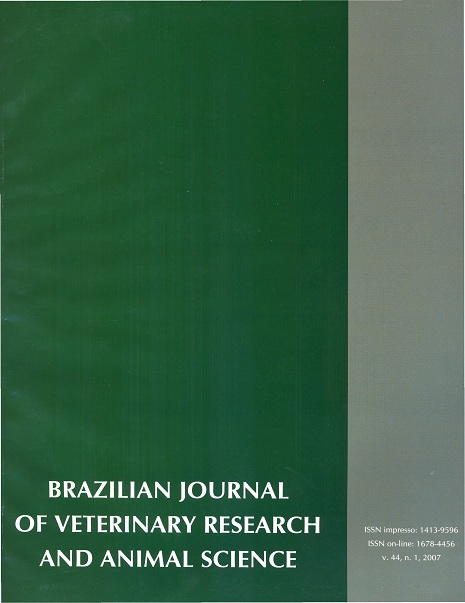Molecular diagnosis of Leptospira spp. in culled sows
DOI:
https://doi.org/10.11606/issn.1678-4456.bjvras.2007.26655Keywords:
Molecular diagnosis, Leptospira spp, Culled sowsAbstract
Leptospirosis diagnosis was performed through molecular, histopathological and serological tests in 30 culled sows in Rio Grande do Sul, Brazil. The objectives were to compare the efficiency of the three methods, to verify the sensitivity of a PCR methodology using a single primer based on the sequence of a repetitive element of Leptospira interrogans genome, as well as to verify the possible detection of Leptospira in several tissue including the genital tract of sows. The animals were selected based on the microscopic agglutination test in order to have sows with negative and positive results, presenting low and higher serologic titers. The higher frequency (90 % of the positive sows) and titers (100 to 800) was observed for L. interrogans serovar bratislava. Leptospira was detected by histopathology in nine sows only, all presenting higher serologic titers (at least 100). A PCR product of 438 bp was observed in all animals (25 kidneys, 24 uterus and 9 oviduct) fragments. Similar PCR product was obtained for DNA from cultures of other pathogenic leptospires, while the pattern observed for the non-pathogenic L. patoc was distinct. No Leptospira spp DNA amplification product was detected in Escherichia coli, Proteus mirabilis, Pseudomonas aeruginosa, Salmonella sp, Streptococcus sp and Staphylococcus aureus DNAs obtained from cultures, or in blood DNA samples of two piglets. The molecular system was therefore specific and the most effective to detect low pathogen levels, being able to differentiate pathogenic from non-pathogenic leptospires.Downloads
Downloads
Published
2007-02-01
Issue
Section
UNDEFINIED
License
The journal content is authorized under the Creative Commons BY-NC-SA license (summary of the license: https://
How to Cite
1.
Oliveira SJ de, Bortolanza F, Passos DT, Pires-Neto JAS, Fallavena LCB, Weimer T de A. Molecular diagnosis of Leptospira spp. in culled sows. Braz. J. Vet. Res. Anim. Sci. [Internet]. 2007 Feb. 1 [cited 2025 Apr. 6];44(1):18-23. Available from: https://www.revistas.usp.br/bjvras/article/view/26655





